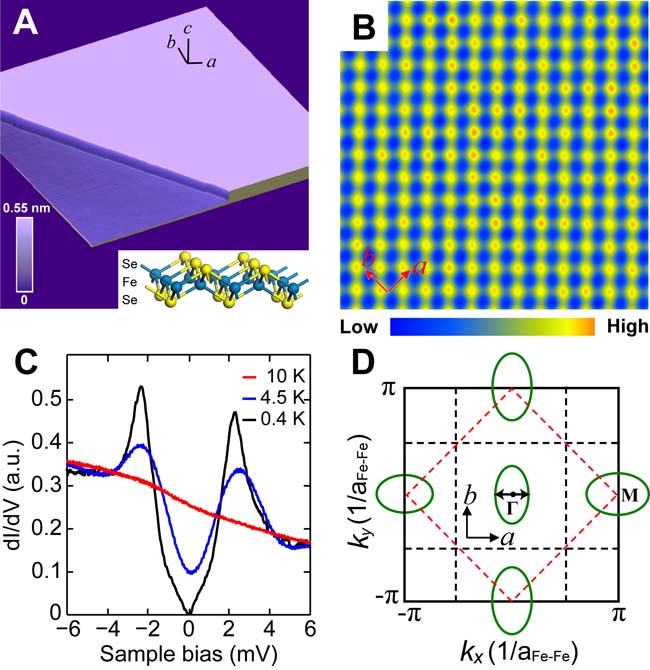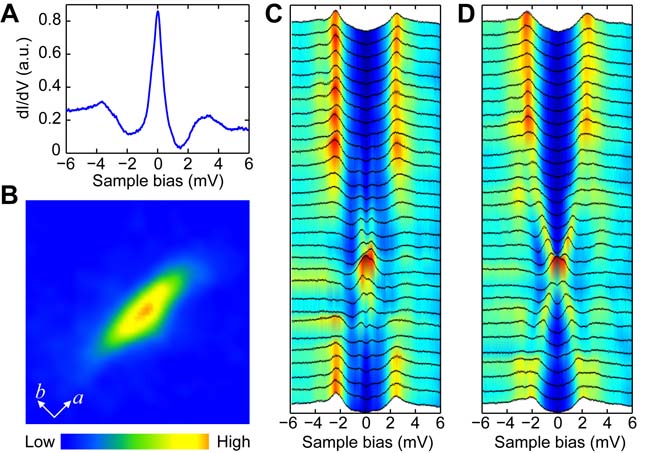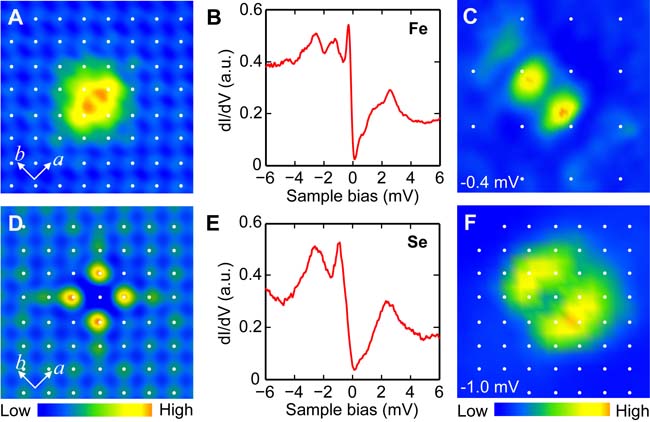The discovery of iron-based superconductors breaks the monopoly on the family of high-temperature superconductors (HTS) held by copper-oxides (cuprates), and opens up a new avenue in the study of high-T
c superconductivity. Similar to the studies of cuprates, one of the central issues in the study of iron-based superconductors is to determine the electron pairing symmetry and to understand the mechanism of high-T
c superconductivity. Despite the intense investigation in the last four years, the pairing symmetry in the newly discovered iron-based superconductors remains elusive, partially from the inhomogeneous samples. To address this issue, superconducting single crystals or films with extremely high quality are in urgent need.
Among all iron-based superconductors, PbO-type β-FeSe has the simplest chemical structure and can be an archetype system for unraveling the mechanism of superconductivity. The FeSe single crystals and films reported so far, however, are known to suffer from great fluctuation in stoichiometry, disorder and clustering pathologies. Moreover, for heteroepitaxial FeSe films the lattice-mismatch between the films and substrates introduces compressive or tensile strain into the films, which becomes more dramatic in ultra-thin films. The situations make the understanding of their superconductivity more challenging.
Recently, the group led by Prof. Xucun Ma of Institute of Physics, Chinese Academy of Sciences, collaborated with the group led by Prof. Qi-Kun Xue of Department of Physics, Tsinghua University, has made significant progress in the study of electron pairing symmetry of FeSe superconductor. By using state-of-art molecular beam epitaxy (MBE) technique, stoichiometric and superconducting FeSe single crystalline films with extremely high quality was successfully prepared (Figs. 1A and 1B). Layer-by-layer growth of high quality films has been achieved in well-controlled manner under Se-rich condition, which allows to investigate the thickness dependent superconductivity of FeSe. In situ low temperature scanning tunneling spectra reveals that the local superconducting gap in the quasiparticle density of states remains robust down to two triple layers for the minimum measurement temperature of 2.2 K. The growth conditions established here can be applied to grow other iron-based superconductor films with high quality (Phys. Rev. B 84, 020503 (2011)).
With such samples, the superconducting gap measured by scanning tunneling spectroscopy at ultralow temperature (0.4 K) shows a V-shaped feature (Fig. 1C), which clearly reveals the existence of line nodes. More importantly, by introducing magnetic field and impurities such as Fe and Se adatoms and Se vacancies with precisely controlled composition, the quantized vortices, bond states in vortex center and the evolution of bond states were investigated (Figs. 2 and 3). Both vortex structure and evolution of bond states show two-fold symmetry, providing the direct proof for that the electron pairing function in FeSe is two-fold symmetry, rather than four-fold symmetry. In collaboration with the theoretical group led by Prof. Cong-Jun Wu in University of California-San Diego, they proposed that the four-fold symmetry breaking may originate from the orbital-dependent reconstruction of electronic structure in FeSe.
These findings provide conclusive experimental evidence for understanding the superconducting mechanism of FeSe. The information is also indispensable and helpful to the hot research in other iron-based superconductors. The main research results have been published in Science on 17 June, 2011 (Science 332, 1410 (2011)).
The work was financially supported by National Science Foundation, Ministry of Science and Technology of China, and Chinese Academy of Sciences.
 |
| Fig. 1. STM characterization of the as-grown FeSe films. (A) Topographic image (2.5 V, 0.1 nA, 200 × 200 nm2) of a FeSe film (about 30 unit cells thick). The step height is 5.5 Å. Inset shows the crystal structure. (B) Atomic resolution STM topography (10 mV, 0.1 nA, 5 × 5 nm2) of FeSe film. The bright spots correspond to the Se atoms in the top layer. a- and b- correspond to either of Fe-Fe bond directions. The same convention is used for a- and b-axes throughout the paper. (C) Temperature dependence of differential conductance spectra (setpoint: 10 mV, 0.1 nA). (D) Schematic of the unfolded Brillouin zone and the Fermi surface (green ellipse). The nodal lines for coskxcoskyand (coskx+ cosky) gap functions are indicated by black and red dashed lines, respectively. The size of all pockets is exaggerated for clarity. The black arrow shows the direction of nesting. |
 |
| Fig. 2. The vortex core states. (A) STS (setpoint: 10 mV, 0.1 nA) on the center of a vortex core. (B) Zero bias conductance map (40 × 40 nm2, setpoint: 10 mV, 0.1 nA) for a single vortex at 0.4 K and 1 Tesla magnetic field. (C and D) Tunneling conductance curves measured at equally-spaced (2 nm) distance along a- and b-axes. |
 |
| Fig. 3. Impurity induced bound states in superconducting gap. (A to C) STM topography (10 mV, 0.1 nA, 3 × 3 nm2), dI/dV spectrum (0.4 K, setpoint: 10 mV, 0.1 nA) and density of states map (-0.4 mV, 0.1 nA, 1.5 × 1.5 nm2) of a single Fe adatom. (D to F) STM topography (10 mV, 0.1 nA, 3 × 3 nm2), dI/dV spectrum (0.4 K, setpoint: 10 mV, 0.1 nA) and density of states map (-1.0 mV, 0.1 nA, 3 × 3 nm2) of a single Se vacancy. The white dots indicate the topmost Se atoms. For each impurity type, at least 5 impurities were measured, and the energies of the bound states were found to be reproducible within an error of 0.1 meV. |




